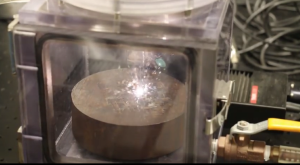 A 3D printing innovation capable of making stronger, lighter metal works for auto, aerospace industries, through a new, 3-D printing technology is being commercialized through Frontier Additive Manufacturing LLC, a Crawfordsville, Indiana-based company. The patented technology was developed in the laboratories of Gary Cheng, a Purdue University associate professor of industrial engineering and Yung Shim, a Purdue professor of mechanical engineering. “The conventional 3D methods of creating metal parts for any type of machinery only have about 60 to 70 percent of the current strength of an original part,” said Cheng, who also is the director of the Scalable Micro Nano Manufacturing Center at Purdue. “We are finding solutions to this problem through the use of novel 3D printers that reconstruct the parts at the smallest micro-structure level currently available.”
A 3D printing innovation capable of making stronger, lighter metal works for auto, aerospace industries, through a new, 3-D printing technology is being commercialized through Frontier Additive Manufacturing LLC, a Crawfordsville, Indiana-based company. The patented technology was developed in the laboratories of Gary Cheng, a Purdue University associate professor of industrial engineering and Yung Shim, a Purdue professor of mechanical engineering. “The conventional 3D methods of creating metal parts for any type of machinery only have about 60 to 70 percent of the current strength of an original part,” said Cheng, who also is the director of the Scalable Micro Nano Manufacturing Center at Purdue. “We are finding solutions to this problem through the use of novel 3D printers that reconstruct the parts at the smallest micro-structure level currently available.”
“We are commercializing a multiple-laser method to create products at the micro-structural level that exceeds current 3D printing capabilities’ structural integrity with the ability to adjust material properties in the original location of the part,” said Eric Lynch, president and co-founder of Frontier Additive Manufacturing. “These are replacement or new products that could easily replace new or worn parts in manufacturing machinery, automotive or aerospace engines. The technology is developing quickly, and we are already successfully engaged with the medical implant industry. We also are in discussions with the automotive, aerospace and oil and gas industries.”
Frontier Additive Manufacturing’s technology will be able to create a finished product in one setup from a CAD design that can be used to replace worn parts in manufacturing with drop-in capabilities where no other modifications are needed for the replacement part to function as an original.
“In addition to producing stronger, lighter parts, with our technology, we will be able to make these parts in a much shorter amount of time,” Lynch said. “For example, we will be able to manufacture the part all in one work center, performing both additive and subtractive operations as well as material adjusting processes, without stopping the manufacturing process to go to another work center. This could save many days on just on one part.”



